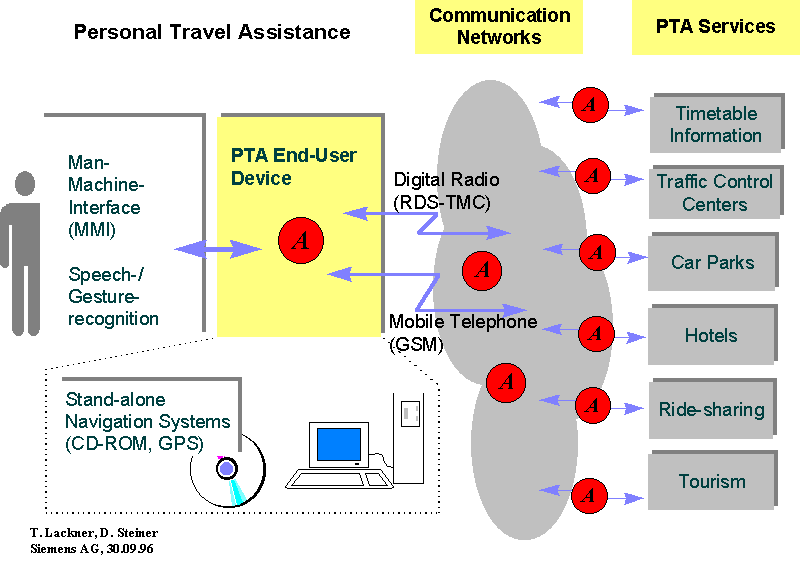
| Submitters | Submitters (cont.) | |||
| G. Obert | BMW AG | L. Frey | Adam Opel AG | |
| U. Kersken | Robert Bosch GmbH | H. Gerber | Philips GmbH | |
| P. Beck | Daimler-Benz AG | D. Steiner | Siemens AG | |
| N. Gundel | debis Systemhaus GEI | M. Junge | Volkswagen AG | |
| W. Stoll | IBM Deutschland GmbH | |||
| Primary Contact | ||||
| D. Steiner | Siemens AG ZFE T SN 5 Otto-Hahn-Ring 6 D-81739 Munich Germany | tel: +49 89 636 42590 fax: +49 89 636 49802 donald.steiner@zfe.siemens.de | ||
A wide variety of travel related services are becoming increasingly available through electronic means. There is a need for convenient and ready access to these services, in particular for travelers who are on the road. This poses a prime example for the benefits of agent technology. Agents operating on behalf of their users can provide assistance in the pre-trip planning phase, as well as during the on-trip execution phase of a trip. The PTA (Personal Travel Assistance) project of the recently initiated German MOTIV Program (Mobility and Transport in Intermodal Traffic) is developing a system for supporting this application area; the submitters of this proposal are members of the MOTIV-PTA project.
The PTA agents will semi-autonomously interact with the user, with other agents - e.g., media agents, with directory services (yellow and white pages), with information brokers that seek, evaluate, and deliberate on information, with data bases, and media indexing services. The PTA system further involves the configuration and delivery - at the right time, cost, QoS, and appropriate security and privacy measures - of trip planning and guidance services (e.g. intermodal route planning, hotel and parking-lot reservations, indvidualised traffic guidance, tourism).
The proposal describes the general PTA architecture, shows the role of agents in establishing a PTA system and shows the relevance of the application to FIPA.
The application proposed herein focuses on two "core" uses of (multi-)agent technology:
A preliminary architecture is given in the following diagramm.

The user accesses the PTA System via a variety of standard end-user computing devices (called PTA Devices). They are primarily
Interaction among these devices may be desirable. (E.g. when leaving the car, the user may want to download a local map onto his PIC, or the PIC should be aware of recent changes to the user's Schedule+ appointments.) It is envisioned that a user agent resides on the end-user device, providing an intelligent interface between the user and the PTA system. The user agent keeps a record of the user's preferences (preferably learning them over time) and goals, keeps abreast of latest developments related to the user's travel plans, and makes suggestions to the user accordingly.
A variety of travel services (called PTA Services) are integrated into the system by agents establishing a common "front-end" for automated access to these services. Examples of such services are:
A goal of MOTIV-PTA is to make integration of new systems as painless and straightforward as possible, allowing for a wide variety of competing services.
A variety of communication services are available for relaying information and data between the PTA devices and PTA services:
Each has their own advantages and disadvantages in terms of cost, bandwidth and reliability. Another goal of the MOTIV-PTA project is to establish a common communication platform which allows seamless integration of the agent communication layer into standard communication transport mechanisms.
As seen above, the agents underlying this proposed application need to
Each of these issues is a target of standardisation within FIPA. In particular, the interaction among PTA agents may be roughly categorized as in the following:
| Agent-Agent Interaction Types | ||||
| General Information Query | Personalised
Information Query | Commitments | Negotiation | |
| PTA Service Examples | Timetables | Route Planning | Reservations (Car Park, Hotel) | Prices (Car Park, Hotel) |
| Traffic Congestion | Event Notification | Ride-sharing | Ride-sharing | |
| Occupancy (Car Park, Hotel) |
Thus we believe this application is well suited for facilitating FIPA's goals to identify generic agent technologies, specify their further development, and enable and enhance interoperability among applications.
The proposed application area is being examined in the following European international, national and state projects, with which the proposers and other FIPA members are associated. (The proposers welcome any information about similar projects within or outside of Europe.)
Thus, the standards developed in FIPA targeting this application area will have an important impact on the latest efforts to ensure mobility in modern society.